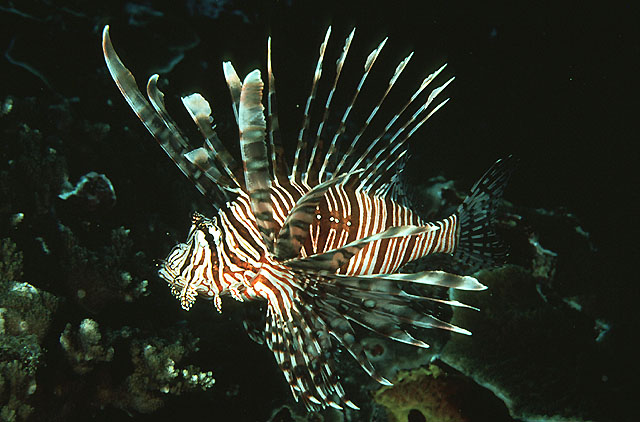| Scorpaenidae (Scorpionfishes or rockfishes), subfamily: Pteroinae |
| 45.7 cm TL (male/unsexed); max.weight: 1,442.0 g; max. reported age: 10 years |
|
reef-associated; marine; depth range 2 - 55 m |
| Pacific Ocean: Cocos-Keeling Islands and Western Australia (Ref. 27362) in the eastern Indian Ocean to the Marquesas and Oeno (Pitcairn group), north to southern Japan and southern Korea, south to Lord Howe Island, northern New Zealand, and the Austral Islands. Replaced by the very similar Pterois miles from the Red Sea to Sumatra. |
|
Dorsal spines (total): 13-13; Dorsal soft rays (total): 9-12; Anal spines: 3-3; Anal soft rays: 6-8. Scales cycloid (Ref. 37816). Variable in color, usually in relation to habitat. Coastal species generally darker, sometimes almost black in estuaries. Often with large tentacles above eyes (Ref. 48635).
Description: Characterized by head and body having reddish-brown bars and bands; free dorsal spines with relatively broad posterior membrane; enlarged and wing-like pectoral fins with incised membranes of upper rays nearly to base, unbranched rays; depth of body 2.7-2.9 in SL (Ref. 90102). |
| Inhabit lagoon and seaward reefs from turbid inshore areas to depths of 50 m. Often solitary, they hide in unexposed places at daytime often with head down and practically immobile. Pelagic juveniles expatriate over great distances and the reason for their broad geographical range (Ref. 48635). Hunt small fishes, shrimps, and crabs at night, using its widespread pectorals trapping prey into a corner, stunning it and then swallowing it in one sweep. Dorsal spines are venomous; the sting can be treated by heating the afflicted part and application of corticoids (Ref. 5503). A popular table fish. |
|
Least Concern (LC); Date assessed: 03 March 2015 Ref. (130435)
|
| venomous |
Source and more info: www.fishbase.org. For personal, classroom, and other internal use only. Not for publication.
